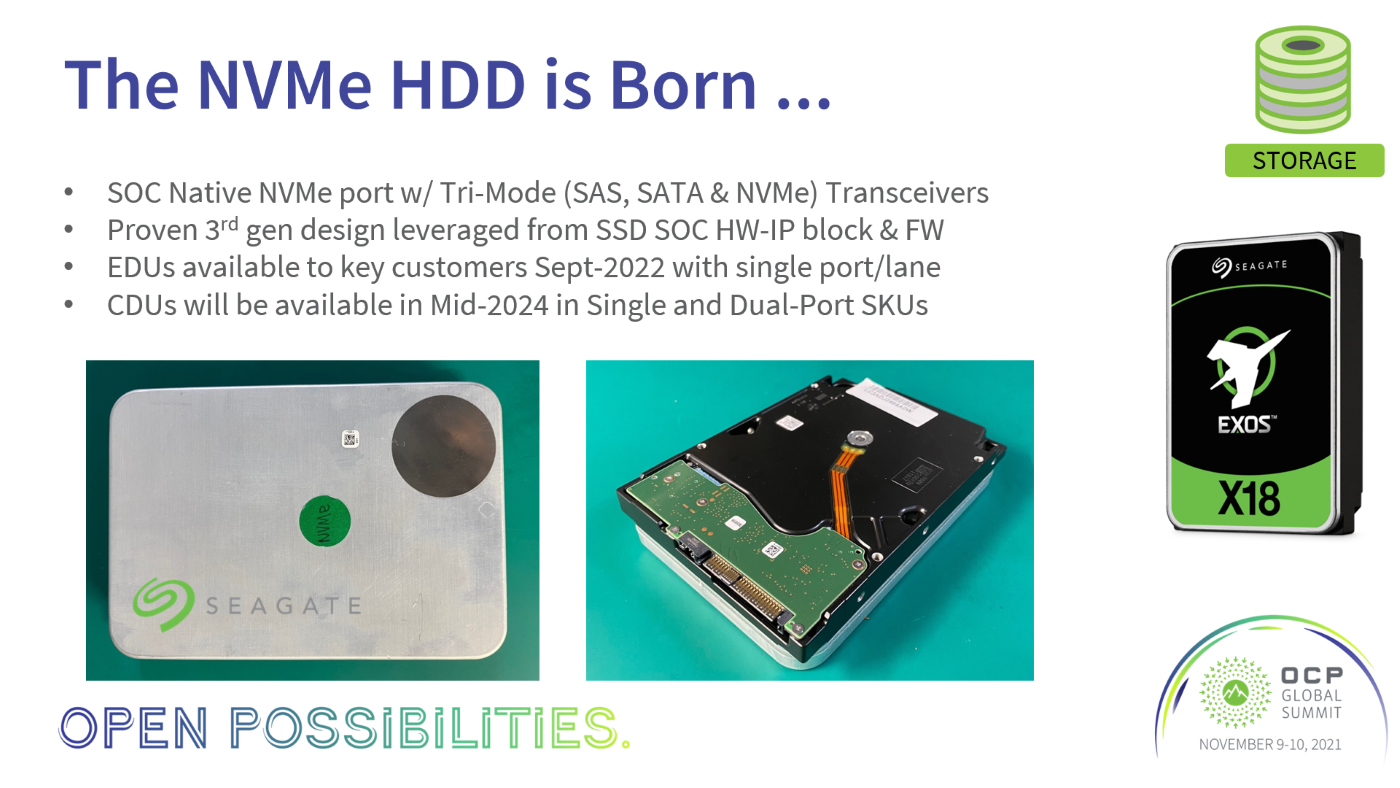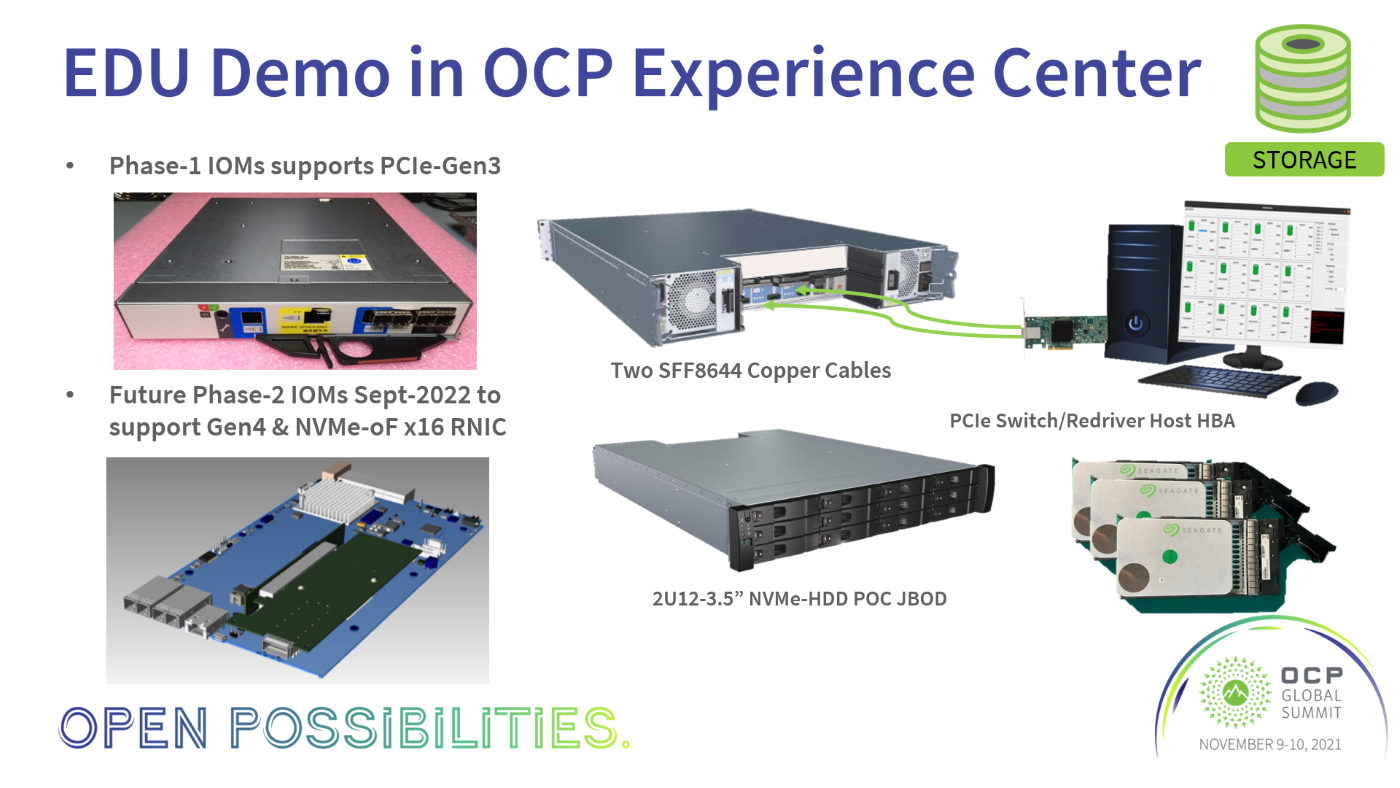Seagate Demonstrates HDD with PCIe NVMe Interface (Updated)
HDDs to adopt PCIe/NVMe interface in 2024.
Update 11/16/2021 03:58 PT:
Seagate has indicated that the first commercial NVMe hard drives will not ship in 2024. This information has been added to the main story.
Original Article
Seagate has demonstrated the industry's first hard disk drive connected to a host using a PCIe interface at the Open Compute Project Summit. Like solid-state drives, the experimental hard drive uses the NVMe protocol to operate alongside SSDs seamlessly. Usage of a single protocol for different types of storage devices will greatly simplify datacenters.
The experimental SSD is based on Seagate's proprietary controller that supports all three major protocols, including SAS, SATA, and NVMe over a 'native NVMe port,' and does not require any bridges. The HDD was demonstrated in a proof-of-concept 2U JBOD enclosure that used a relatively simple PCIe switch connecting to 12 3.5-inch drives using a PCIe interface.

Modern HDDs can barely saturate even a single PCIe 2.0 link, but future multi-actuator HDDs promise to be much faster, so 6 Gbps provided by SATA or 12 Gbps offered by SAS might not be enough at some point. To that end, the industry has to think about future interfaces to connect hard drives, and PCIe seems like a natural choice. Furthermore, as SSDs are gaining traction in datacenters, the NVMe protocol becomes pervasive, so it makes sense to adopt it for HDDs. This is why NVMe 2.0 adds hard drive support.
Added incentives for using the same physical interface and logical protocol for HDDs and SSDs simplifying hardware and software for datacenters, which means streamlined feature development, easier scaling, and reduced cost of ownership.
Get Tom's Hardware's best news and in-depth reviews, straight to your inbox.

Adoption of PCIe-connected HDDs will take quite some time. Seagate says that the first customer development units (CDUs) of PCIe/NVMe HDDs will be available to key customers in September 2022, almost a year from now. These will be followed by customer test units (CTUs) that are planned for 2024. These CTUs only pertain to large scale enterprise customers and represent small scale shipments of units for testing only, they are not actual commercially available units shipping in volume, Seagate said. For now, Seagate seems to position PCIe/NVMe HDDs primarily for datacenters and does not indicate when it might ship them commercially. However, the transition to a brand-new interface and protocol is ideal for client PCs since it increases performance and simplifies architecture. Yet, transition of client HDDs to a new interface is probably slated for a very long term future.
To put Seagate's PCIe/NVMe HDD plans into the context of the company's roadmap, expect the first commercial hard drives with a PCIe interconnection to use the company's heat-assisted magnetic recording technology, utilize one or two actuators, and feature a capacity between 30TB and 40TB.

Anton Shilov is a contributing writer at Tom’s Hardware. Over the past couple of decades, he has covered everything from CPUs and GPUs to supercomputers and from modern process technologies and latest fab tools to high-tech industry trends.
-
hotaru.hino Before anyone asks "but why? HDDs are too slow to take advantage of it!"Reply
It simplifies how many protocols we need in order to talk to storage (well it says it in the article too, but I'm sure a lot of people will rush here seeing the headline) -
peachpuff As long as we can connect the same amount of drives to the mobo as we can now then sure. But if you add some dumb limitations that there aren't enough lanes for 8 hdd's then gtfu.Reply -
InvalidError Reply
This stuff will hit datacenters first where its main benefit is going to be allowing server gear manufacturers to use a 4.0/5.0x4/8/16 PCIe switch to directly fan out to 40-80 HDDs instead of having to use layers of fancy SAS or other hardware.hotaru.hino said:It simplifies how many protocols we need in order to talk to storage (well it says it in the article too, but I'm sure a lot of people will rush here seeing the headline) -
truerock A single interface to the CPU for external data access is a great idea.Reply
There still would need to be some organization around connectors, I suppose.
NVMe and Thunderbolt/USB overlap quite a bit. I guess it wouldn't take too much effort to simplify and establish a unified standard.
Keyboards, SSDs, video monitors, lazer etc -
InvalidError Reply
The problem with unified standards is that they end up being extremely wasteful: you don't want to use a full 3.2-gen2x2/USB4/5.0x4/TB5/whatever port with a bunch of alt-mode support on a HDD that can barely make use of a 3..0x1-wide interface.truerock said:NVMe and Thunderbolt/USB overlap quite a bit. I guess it wouldn't take too much effort to simplify and establish a unified standard.
IMO, there needs to be a SATA successor using PCIe 4.0+/NVMe with combined 12V power + data in x1 and x4 flavors. For backwards compatibility, the x1 ports could support SATA/SAS via adapters that pass data lines straight through and provide the 5VDC converter for legacy devices. -
elementalRealms The NVME interface will allow the harddisk cache to be accessed much much faster than ANY SATA or SAS interface !!! (you calculate how many folds) ... and the Hybrid SSD/HDD will be blazing fast as well . This is coming to the desktop soon!Reply -
hotaru.hino Reply
While NVMe is designed around PCIe based SSDs, I also don't believe that NVMe actually requires a PCIe based PHY layer, since NVMe is also meant to take over the AHCI protocol. Especially considering that AHCI worked over PCIe via SATA Express.InvalidError said:The problem with unified standards is that they end up being extremely wasteful: you don't want to use a full 3.2-gen2x2/USB4/5.0x4/TB5/whatever port with a bunch of alt-mode support on a HDD that can barely make use of a 3..0x1-wide interface.
IMO, there needs to be a SATA successor using PCIe 4.0+/NVMe with combined 12V power + data in x1 and x4 flavors. For backwards compatibility, the x1 ports could support SATA/SAS via adapters that pass data lines straight through and provide the 5VDC converter for legacy devices.
Maybe we could still use SATA ports, assuming the controllers are generic enough to only handle bit integrity before handing it off to the OS. -
InvalidError Reply
NVMe doesn't have a PHY layer of its own, it is just a device protocol spec that can be encapsulated to run on any suitable L2-L3 protocol stack.hotaru.hino said:While NVMe is designed around PCIe based SSDs, I also don't believe that NVMe actually requires a PCIe based PHY layer
Maybe we could still use SATA ports, assuming the controllers are generic enough to only handle bit integrity before handing it off to the OS.
I doubt the SATA cables and connectors were intended for 16-32Gbps (look at USB3.2-gen2's shielded micro-headers for 10Gbps lanes) and with 12VO sounding the beginning of the end for 3.3V and 5V from the PSU, a new connector or two would kill 2-3 birds with one stone. Imagine being able to have 4.0x4 NVMe SSDs in 2.5" form factor - your SSD doesn't have to live buried under the GPU anymore and you don't need a PSU cable + motherboard cable (or two cables from motherboard) going to the SSD either. -
Alvar "Miles" Udell A 2.5" form factor would allow for a much larger and more elegant heatsink design than the M.2 form factor for sure, especially as SSDs become faster and warmer. I can't see it replacing the M.2 form factor, but possibly co-existing with it much as AICs do now.Reply -
hotaru.hino Reply
I'm not suggesting running a fast speed over SATA cables. I'm only suggesting we can reuse the existing SATA hardware to connect NVMe based HDDs and all it would take is a driver update.InvalidError said:NVMe doesn't have a PHY layer of its own, it is just a device protocol spec that can be encapsulated to run on any suitable L2-L3 protocol stack.
I doubt the SATA cables and connectors were intended for 16-32Gbps (look at USB3.2-gen2's shielded micro-headers for 10Gbps lanes) and with 12VO sounding the beginning of the end for 3.3V and 5V from the PSU, a new connector or two would kill 2-3 birds with one stone. Imagine being able to have 4.0x4 NVMe SSDs in 2.5" form factor - your SSD doesn't have to live buried under the GPU anymore and you don't need a PSU cable + motherboard cable (or two cables from motherboard) going to the SSD either.